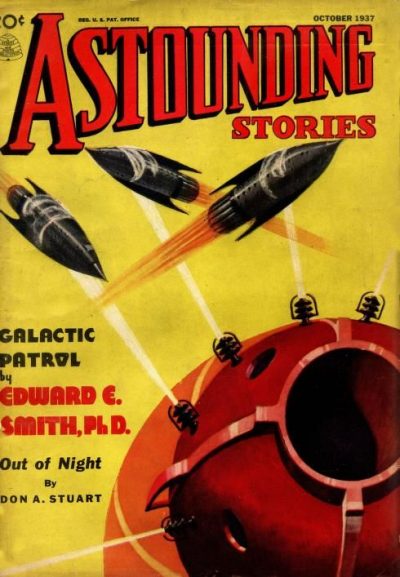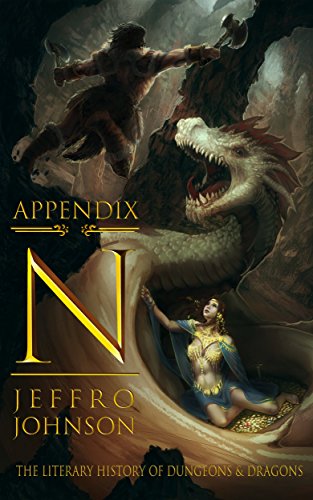 The opening shot of Star Wars with its slow reveal of a truly gigantic Star Destroyer is arguably the finest single shot in science fiction movie history. It’s so powerful, it not only changed the way blockbuster movies were made from then on. It turned nearly an entire generation into science fiction fans over night!
The opening shot of Star Wars with its slow reveal of a truly gigantic Star Destroyer is arguably the finest single shot in science fiction movie history. It’s so powerful, it not only changed the way blockbuster movies were made from then on. It turned nearly an entire generation into science fiction fans over night!
Of course, those newly minted fans looking for more of the same were in for a shock. There just isn’t anything really approaching an epic space battle in Isaac Asimov’s Foundation trilogy. (The battle cruisers of the second volume are completely impotent against the “dead hand” of Hari Seldon.) Arthur C. Clarke’s 2001 opens with divine intervention in man kind’s evolutionary prehistory and culminates into a baffling conclusion that not even the novel can satisfactorily explain. People that turned to Heinlein’s Starship Troopers got their nuclear powered infantry, sure. But they got half again as much lecture on why they needed to spank their puppies.
But no, this middle brow and vaguely “serious” take on the field may be synonymous with written science fiction fans of a particular age range. But it sure wasn’t primary to people that sat down to make the first wave of role-playing games. There you got the gritty “bullets and blades in space” of authors like H. Beam Piper, E. C. Tubb, Poul Anderson, and Jerry Pournelle for what would inspire Traveller. Or you got the wild and freaky science fantasy of post apocalyptic mutant adventure from authors like Andre Norton, Sterling Lanier, and Brian Aldiss for what would inspire Gamma World and Metamorphosis Alpha.
Looking at just these three distinct science fictional oeuvres, one would think that Star Wars just came out of nowhere like lightning out of a clear sky. It didn’t, of course; it followed from the pulpier planetary romance style of science fiction pioneered by Edgar Rice Burroughs which dominated the field right up through about 1940 with countless spin-offs and variations produced by science fiction luminaries such as C. L. Moore, Leigh Brackett, and Jack Vance.
But even with that as a given, the question remains. Where is the must-read classic science fiction novel that gives the exact same sense of awesomeness as that gigantic Star Destroyer from the opening shot of Star Wars? Where is the book that anticipates the epic thrill people felt when the witnessed the Millennium Falcon make the jump to light speed for the first time? Where is the book that captures the brutality of a boarding party of stormtroopers systematically taking over a starship or tremendous weapons capable of destroying a planet…?
 Well that book, the book that holds the distinction of getting to all of that firstest with the mostest has to be E. E. “Doc” Smith’s Galactic Patrol. And let me tell you it’s got everything. Giant starships, tractor beams, force shields, space marines, and explosive pulse-pounding action. The fact of its wide-ranging appeal and enduring influence would be immediately evident to anyone familiar with The Green Lantern Corps, but the question remains….
Well that book, the book that holds the distinction of getting to all of that firstest with the mostest has to be E. E. “Doc” Smith’s Galactic Patrol. And let me tell you it’s got everything. Giant starships, tractor beams, force shields, space marines, and explosive pulse-pounding action. The fact of its wide-ranging appeal and enduring influence would be immediately evident to anyone familiar with The Green Lantern Corps, but the question remains….
Why would something this astounding go pretty well dormant until stuff like Fred Saberhagen’s Berserker series, Star Wars, and Battlestar Galactica could make it the new normal again…?
It’s hard to believe, but that actually happened.
Why would that happen…? And more importantly, how could it happen? Well, that’s a long story, really. One place to start would be to check in on the people that make the short lists of science fiction’s seminal classics. If the people you’ve depending on to point you to the crème de la crème of science fiction can’t be bothered to pay their respects to A Princess of Mars and Galactic Patrol, then they’re selling you a bill of goods.
And it’s long past time for somebody to make a better list– one that captures science fiction’s real history.
Heinlein didn’t write like Burroughs or Doc Smith, but unless you are a master of sword and pistol who keeps your woman naked but for her weapons and the emeralds you put on her flesh, he was probably more of a Burroughs fan than you. And he was a personal friend of Doc. The link between the core of SF- Poul Anderson, Heinlein, Niven, Pournelle, Zelazny- and the space opera of H Beam Piper and Doc Smith and Poul Anderson, is obvious. The gap between them isn’t.
“Heinlein didn’t write like Burroughs or Doc Smith”
I thought that was the point.
“And it’s long past time for somebody to make a better list– one that captures science fiction’s real history.”
Do I smell a sci-fi version of Appendix N 🙂 ?
= + =
As an aside, a few years ago I did the maths for Doc Smith’s Lensman universe. Some fun numbers, because apparently people think Star Wars had “epic” battles…
By the end of “Children of the Lens”, Civilisation had:
-68.5 billion planets.
-6.85 trillion Lensmen graduating every year.
-5.48 trillion warships (all superdreadnoughts) in Grand Fleet. Number probably higher, as not every ship would be a superdreadnought, but many would be smaller ships.
-Top income tax rate of ~3.5%, when Boskone’s piracy was at its height (!). And that was a bit on the high side…
I think the skeleton crew for a superdreadnought like the Dauntless was something like 400 men, by the way.
…
I *really* want that Lensman movie now :-/ …
-
Appendix N has Sci Fi on it though.
-
Yes, but I was thinking more of doing for sci-fi what Appendix N did for D&D. That is, showing where it all came from, how it evolved, and so on.
-
-
This may or may not be of interest to you: my own list of the 50 essential authors of Science Fiction. Think of it as my personal appendix N list.
http://www.scifiwright.com/2012/01/the-fifty-essential-authors-of-science-fiction/
Really like to see an Appendix N for SF.
Smith was a huge A. Merritt fan. He mentions “the immortal Merritt” in GREY LENSMAN and he praised Merritt in other venues as well.
https://en.wikipedia.org/wiki/E._E._Smith#Literary_influences
George Lucas and J. Michael Straczynski have both admitted to being Doc Smith fans.
Given this warm praise of Doc Smith, now you see why I wondered why you didn’t include him on your Space Opera list. I know I got annoying at every time Jeffro made an SF list that didn’t have Doc Smith on it, but I feel Smith’s works are essential part of SF, and bristled at their exclusion. Especially with Space Opera, a genre many credit him for starting (I know it’s disputed, but I think it’s safe to argue he’s a huge influence on it.)I know I am late on this comment, but it’s good to see you touch on a Smith Work before leaving the Blog.